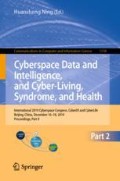Abstract
The Dempster-Shafter combination rule often get wrong results when dealing with severely conflicting information. The existing typical improvement methods are mostly based on the similarity of attributes such as evidence distance, similarity and information entropy attribute as evidence weight correction evidence itself. Ultimately, the final weights of the evidences are applied to adjust the bodies of the evidences before using the Dempster’s combination rule. The fusion results of these typical methods are not ideal for some complex conflict evidence. In this paper, we propose a new improved method of conflict evidence based on weighted credibility interval. The proposed method considers the credibility degree and the uncertainty measure of the evidences which respectively based on the Sum of Absolute Difference among the propositions and the credibility interval lengths. Then the original evidence is modified with the final weight before using the Dempster’s combination rule. The numerical fusion example has verified that the proposed method is feasible and improved, in which the basic probability assignment (BPAs) to identify the correct target is 99.21%.
Access this chapter
Tax calculation will be finalised at checkout
Purchases are for personal use only
References
Gravina, R., Alinia, P., Ghasemzadeh, H., Fortino, G.: Multi-sensor fusion in body sensor networks: state-of-the-art and research challenges. Inf. Fusion 35, 68–80 (2017)
Fu, C., Xu, D.-L.: Determining attribute weights to improve solution reliability and its application to selecting leading industries. Ann. Oper. Res. 245, 401–426 (2014)
Dempster, A.P.: Upper and lower probabilities induced by a multivalued mapping. Ann. Math. Stat. 38(2), 325–339 (1967)
Yager, R.R.: On the Dempster-Shafer framework and new combination rules. Inf. Sci. 41(2), 93–137 (1987)
Murphy, C.K.: Combining belief functions when evidence conflicts. Decis. Support Syst. 29(1), 1–9 (2000)
Deng, Y., Shi, W., Zhu, Z., Liu, Q.: Combining belief functions based on distance of evidence. Decis. Support Syst. 38(3), 489–493 (2004)
Zhang, Z., Liu, T., Chen, D., Zhang, W.: Novel algorithm for identifying and fusing conflicting data in wireless sensor networks. Sensors 14(6), 9562–9581 (2014)
Yuan, K., Xiao, F., Fei, L., Kang, B., Deng, Y.: Conflict management based on belief function entropy in sensor fusion. Springerplus 5(1), 638 (2016)
Xiao, F.: Multi-sensor data fusion based on the belief divergence measure of evidences and the belief entropy. Inf. Fusion 46, 23–32 (2019)
Fan, X., Zuo, M.J.: Fault diagnosis of machines based on D-S evidence theory. Part 1: D-S evidence theory and its improvement. Pattern Recognit. Lett. 27(5), 366–376 (2006)
Yuan, K., Xiao, F., Fei, L., Kang, B., Deng, Y.: Modeling sensor reliability in fault diagnosis based on evidence theory. Sensors 16(1), 113 (2016)
Jiang, W., Zhuang, M., Qin, X., Tang, Y.: Conflicting evidence combination based on uncertainty measure and distance of evidence. SpringerPlus 5(1), 12–17 (2016)
Wang, J., Xiao, F., Deng, X., Fei, L., Deng, Y.: Weighted evidence combination based on distance of evidence and entropy function. Int. J. Distrib. Sens. Netw. 12(7), 3218784 (2016)
Fei, L., Wang, H., Chen, L., Deng, Y.: A new vector valued similarity measure for intuitionistic fuzzy sets based on OWA operators. Iran. J. Fuzzy Syst. 15(5), 31–49 (2017)
Acknowledgment
This work was supported by the Nation Natural Science Foundation of China (NSFC) under Grant No. 61462042 and No. 61966018.
Author information
Authors and Affiliations
Corresponding authors
Editor information
Editors and Affiliations
Rights and permissions
Copyright information
© 2019 Springer Nature Singapore Pte Ltd.
About this paper
Cite this paper
Ye, J., Xue, S., Jiang, A. (2019). Multi-sensor Data Fusion Based on Weighted Credibility Interval. In: Ning, H. (eds) Cyberspace Data and Intelligence, and Cyber-Living, Syndrome, and Health. CyberDI CyberLife 2019 2019. Communications in Computer and Information Science, vol 1138. Springer, Singapore. https://doi.org/10.1007/978-981-15-1925-3_6
Download citation
DOI: https://doi.org/10.1007/978-981-15-1925-3_6
Published:
Publisher Name: Springer, Singapore
Print ISBN: 978-981-15-1924-6
Online ISBN: 978-981-15-1925-3
eBook Packages: Computer ScienceComputer Science (R0)

